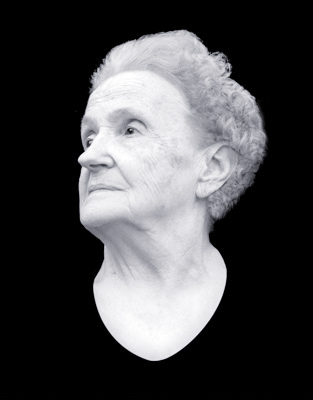
Portrait from All Things Are Always Changing
While Greek sculpture presented the ideal, divinity and perfection; it did not reproduce particular details rather they strove to present an "eternal identity". Romans were concerned with depicting the individual. Their work emerged from veneration of their own ancestors, not veneration of their gods.
The magnificence of Roman portraiture commemorated ancestors, lineage, authority, prowess. We began to photographed older women not simply because of their accomplishments, but to venerate them for having endured, for their wisdom and for their beauty.

Some notes on the evolution of Roman Portraits from Ludwig Goldscheider:
The Etruscans were the first in the Mediterrean to depict natural likeness on their sarcophagus figures. Later, 'every aristocratic or well-to-do middle-class Roman house had in its drawing room, the atrium, al collection of family statues, likenesses of ancestors, cast in wax, death masks. These masks were brought out for special celebrations and worn in funeral processions in order to "resurrect" the loved one so many generations of the family could be represented'. "At the funeral of Julius Caesar there was a pivot, with the face and body showing the three-and-twenty stabs."
To preserve these wax masks, bronze or terra cotta casts were made. The features of the individual were specific, the bodies were generic. Because these masks were not animated living face, techniques were developed to accommodate the principles of an illusionistic style. The use of white marble, skin and hair textural treatment with the use of a drill to intensify highlight and shadow detail, drilling out pupils and emphasis on the eyes as an expressive element.

Portraits began to be made in one's lifetime and used as gifts to friends. Ultimately "the right to the public exhibition of a statue was purchasable in Rome", and no site was thought unworthy of this mark of civic appreciation. Likenesses of prominent citizens as well as gladiators, courtesans, and minions stood in temples among the images of the gods. Though few remain, painted portraits were common and exhibited in public spaces.
By the first through the forth century A.D., imperial likenesses and medallions were multiplied and sent to the the provinces as a way to advertise and consolidate power.

No comments:
Post a Comment